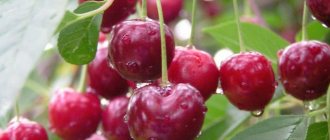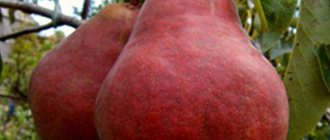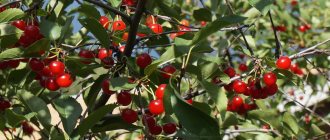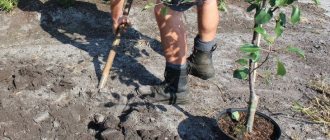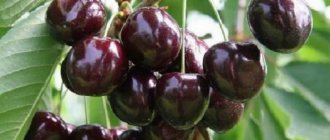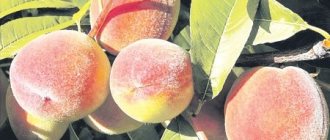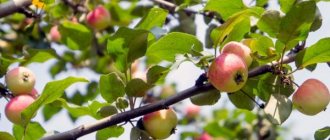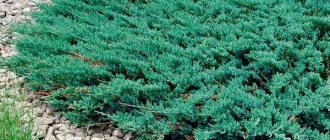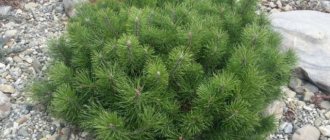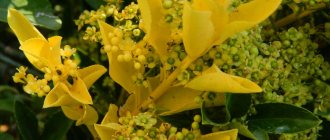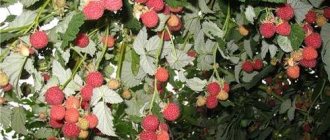Landing Features
The rules for planting peach depend on which variety is chosen for cultivation.
Based on the recommendations of agronomists, it is better to choose mid- and late-ripening varieties for the southern regions. In cooler regions, plants are planted in the spring.
There are certain requirements that must be observed during this procedure:
- most peach trees do not like drafts, dampness and cold wind, so they should not be placed in swampy areas and lowlands;
- It is desirable that the plants have enough sunlight;
- if infertile soil is selected, then before placing trees, and every season, the soil must be fertilized with mineral and organic fertilizers.
Usually, for planting, they dig a hole about 1 meter wide and 0.8 meters deep, add 1 bucket of rotted manure or prepared compost into it, and leave it for two weeks, mixing it with the rest of the soil.
Basic landing rules
It will be possible to grow a columnar peach if you take into account the rules. They select a planting area in advance, prepare the soil, maintain soil moisture levels, and carry out preventive treatment against pests and diseases. The seedling will produce 10-15 kg of fruit with proper care. The planting will be resistant to any negative factors.
Planting of columnar peach in the fall is carried out in the southern regions. In the northern regions, planting is carried out in the spring. The tree quickly adapts and tolerates any temperature fluctuations.
Selection of location and soil
An area with a high level of lighting is prepared for plantings. This will ensure the seedlings full growth and development. Shaded areas are more likely to develop diseases.
Preparatory work on the site begins in advance. Excess vegetation and debris are removed from the soil. The planting site is dug up and saturated with useful components. Humus or rotted manure is added to the soil. If a seedling is planted in the spring, then all preparatory measures are carried out in the fall, and vice versa.
A planting pit about 70 cm deep is dug under the fruit. When planting several seedlings at the same time, a distance of 50-70 cm is maintained between them. A drainage layer is made at the bottom of the hole - a small amount of crushed stone is poured. Sprinkle soil mixed with compost on top. It is not recommended to plant trees in lowlands. This leads to constant accumulation of moisture and death of the plant.
Seedling preparation and planting
Planting columnar peaches in the spring does not present any difficulties for beginners. For a seedling, a wooden stake is inserted into the hole in order to later tie the plant to it.
The seedling is placed in the center of the pit. The roots are straightened in the pit. The empty space is covered with soil and watered under the trunk. When planting in autumn, the tree is wrapped in burlap. The planting site should not be swampy or the tree will begin to rot.
Growing technology
Gooseberries - all the intricacies of growing
Proper planting and care, these two factors are the key to successful cultivation of peach crops in the Moscow region. Moreover, if everything is done correctly, then even in the northern part of this region you can successfully grow this crop. And in order to reap good harvests every year, the following agricultural practices should be followed:
- Before wintering, you need to take care of the safety of the crop by carefully covering it with dry straw and tying the trunk with burlap.
- Starting in May, try to generously water the peach with warm, settled water a couple of times a month. If the summer is dry, feel free to increase the amount of moisture.
- Feed the crop regularly, add nitrogen to the soil in the spring, which helps intensively grow green mass.
- In summer, feed the peach with potassium fertilizers and organic matter.
- In the fall, make sure that the tree is saturated with phosphate fertilizers before wintering and add rotted humus as mulch, which will nourish the peach root throughout the winter and also protect it from frost.
- If the tree has a spreading and lush crown, make some kind of supports for the fruit-bearing branches so that the branches do not break from the weight of the harvest.
- Carry out preventative spraying regularly against infestations of parasites and infections.
In fact, caring for peach crops in open ground is not difficult. The main thing is not to forget to carry out all the above-described manipulations in a timely manner. And of course, try to regularly inspect the trees for timely detection of diseases or parasitic insects. Performing these simple manipulations will definitely give results in the form of juicy fruits.
Varieties of peaches for different regions
Subtleties of growing eggplants you need to know
Like other crops, peaches are divided according to the speed of harvest ripening into early, medium and late. In the south, harvests are formed according to the biological ripeness of all three variety groups; in the middle zone and, especially in the cold zone, even when grown in heated greenhouses and greenhouses, they are limited to growing early and, much less often, medium and mid-early varieties.
In the southern regions and areas close to them in the middle zone, the following early and mid-early varieties of peaches are most acceptable: Kyiv early, Redhaven, Collins, Sochny, Favorit, May Flower, Early Sycheva, Rossoshanskaya early, Nadezhny, Fluffy early and others.
Of the mid-ripe varieties in the southern region, the Cardinal peach variety produces high yields of good quality, the fruits of which reach a weight of 140-150 g.
In the middle zone, the mid-season peach variety Kremlevsky is quite winter-hardy. Large-fruited. The fruits reach a weight of more than 200 g. Other varieties that are in demand are Veteran, Skazka, Zakatny, Smolensky.
We can recommend winter-hardy varieties of peaches from American and Canadian selection (nectarines, peaches with fig-shaped fruits) - Harbinger, Harnas, Inka, Harko, Suncrest and others - for growing on your own plots. Naturally, the listed varieties are given as examples. The market annually offers new, more improved varieties for winter hardiness and resistance to diseases and pests. Before purchasing a new peach variety, you need to carefully familiarize yourself with its characteristics so as not to get into trouble a few years later when it turns out that the variety is unsuitable for the region.
Treatment of peach trees against pests and diseases. Mary H. Dyer
Main characteristics of culture
Peach pruning in Crimea in spring
This type of peaches is compact, and thanks to its moderately sparse crown, it looks aesthetically pleasing and gives the garden landscape a decorative look. The peach tree occupies a small space. Due to the fact that its lateral branches branch weakly, the plant practically does not shade the crops located in the immediate vicinity.
Most trees can be classified as dwarf species, since their height reaches only one and a half meters. At the same time, the crown resembles a cylinder and looks very beautiful, especially when it blooms and bears fruit. Columnar peach usually produces abundant harvests, and its fruits are juicy, sweet, and have an excellent aroma.
It is impossible not to note the valuable qualities of the fruit, saturated with a large amount of vitamins, in particular, tocopherol, retinol and niacin (nicotinic acid). The fruit also contains essential oils, plant acids, saccharides and important mineral compounds.
Pros and cons of columnar peach
Columnar peach seedlings have many advantages. Positive qualities include:
- decorative type of plant;
- high level of productivity;
- large fruit size;
- low maintenance requirements;
- excellent taste and a number of essential vitamins and microelements in the composition;
- resistance to diseases and negative external influences.
The main advantage is the compactness of the planting. It can be grown even in a small garden plot. Planting a columnar peach correctly is not difficult. The main disadvantages include the high cost of seedlings, relatively low yields and the short lifespan of the plant.
Fig peach
Currently, fig peaches are in particular demand among lovers of this crop. In their shape they resemble figs, and many such fruits are called “flat”. This variety is distinguished by the fact that its pulp is very tender and aromatic, sweet and juicy. With a total fruit weight of 180-200 grams, the seed weighs only 3-4 grams.
The tree tolerates cold temperatures well, and due to the fact that the flowers bloom quite late, the negative consequences of spring frosts can be avoided. Also, the yield of fig peach is higher than that of other varieties.
The disadvantages include poor transportability.
Features of dwarf varieties
A columnar tree looks unusual from the side: it has a straight trunk, with short branches extending from it to the sides at a strictly acute angle. In autumn they are covered with fruit, and the seedling resembles a column. This is where the name of these varieties comes from. Despite this, all the fruits are no different from those produced by ordinary trees.
The main feature of dwarf varieties, which explains their demand among gardeners, is their high profitability. Compared to traditional trees, columnar trees produce more yield and are easier to care for.
What else attracts such varieties:
- the small size of the crown and rhizomes, making it easy to grow an orchard even in a small area;
- When planting, a small gap must be maintained between neighboring crops, so their density on the site will be greater. For example, 2000 dwarf seedlings can be planted on 1 hectare, which cannot be said about trees of traditional varieties. No more than 400 of them will fit here.
- the small size of the seedlings - no more than 2.5 meters - makes caring for them easier and easier to harvest;
- such varieties do not require extensive pruning, you just need to monitor the shape of the crown;
- dwarf fruit seedlings bear fruit very early, already a year after they are planted. If you plant ordinary fruit trees, the harvest will occur only after 4-5 years;
- To treat the garden you need very few chemicals due to its miniature size.
Choosing a variety
As mentioned above, for the Moscow region it is worth giving preference to early and mid-ripening varieties of peaches. With such varieties, the gardener will be able to taste delicious fruits as early as July. The only condition is to choose the right variety and provide good care for it.
We have covered everything related to planting and cultivation above; all that remains is to find out which varieties are best suited for a given region. So, the best varieties of peach crops for the Moscow region:
- Redhaven;
- Collins.
If you want to grow incredibly juicy and sweet peaches, then Redhaven is the perfect place for you. This culture has many advantages, namely:
- early fruit ripening;
- fully suits the conditions of the Moscow region;
- ideal for industrial cultivation;
- the fruits of this variety reach a weight of 160 g;
- the crop is resistant to winter frosts and spring night frosts;
- not afraid of curling and American powdery mildew.
It is worth highlighting that if you organize proper care for it, the Redhaven peach will be resistant to infections of fungal origin.
And the second, no less famous variety is Collins. This variety has the following excellent characteristics:
- the average weight of one fruit is 150 grams;
- This peach tastes very sweet;
- this variety is characterized by high yield, so the fruits should be removed on time so that the branches do not break;
- trees of this variety are resistant to powdery mildew and such a dangerous defect as curl;
- can easily withstand even severe frosts;
- The main feature of this variety is that Collins needs regular abundant watering and fertilizing, otherwise the gardener will not see a good harvest.
It is worth noting that this peach variety also belongs to the early ripening varieties. Well, as for the differences between the first and second options, there are two of them: Collins is capable of producing larger yields than Redhaven. But at the same time, the Collins peach is several times more picky about care than the first option.
In addition to the varieties described above, today there are still a lot of different peach representatives, such as the Kyiv early variety, Juicy peach, Kremlyovsky and other varieties. All of them have good frost resistance and are able to delight with tasty fruits even in the northern regions.
And in this case, one thing can be emphasized: when choosing a certain variety, purchase seedlings only in specialized nurseries. Only in this case, with properly organized care, will you get a harvest.
Goals
Peach is a whimsical tree that requires careful and constant care, an obligatory part of which is the formation and pruning of the crown. Correct and timely haircut ensures:
- crown formation: controlling the height of the tree, giving a decorative silhouette, improving access to sunlight and optimal ventilation inside;
- timely and regular fruiting;
- increasing productivity;
- improving the quality of fruits (so that they are large and have excellent taste characteristics);
- increasing the period of fruiting;
- life extension;
- prevention and treatment of diseases;
- rejuvenation;
- stimulation of growth;
- strengthening the immune system;
- full preparation for winter, increasing resistance to low temperatures.
The peculiarity is that the winter hardiness of the peach tree depends on the shape of the crown:
- “spindlebush” (spindle, pyramid, column) winters well in the south (Cherkessk, Makhachkala);
- “bowl” - for the Krasnodar Territory, Rostov-on-Don;
- bush - for central Russia;
- stlanets - for more severe climatic conditions.
The second feature is the “gluttony” of the tree. The process of drawing nutrients from the roots occurs several times faster than in all other plants. Moreover, it uses them to develop branches. Therefore, in spring and summer a huge number of extra buds and shoots are formed. Because of them, the ovaries of future fruits lack nutrition. If you do not prune, only the periphery of the crown will bear fruit. The peaches will be small and tasteless. And the tree itself quickly ages and dies.
Planting and care
In order for the Steinberg peach to develop well, it needs to create certain conditions, namely:
- choose the right landing zone;
- prepare the ground;
- water the plant in a timely manner;
- regularly fertilize the soil;
- carry out preventive measures aimed at combating pests and defects;
- perform a procedure such as pruning annually.
First of all, let's start by choosing a place to plant this crop. So, in order for the trees to develop well, give preference to places where there is a lot of sunlight and neighboring trees do not create shade with their crowns. When choosing a planting area, make sure that the area is not swampy. Garden soil or black soil is best suited for such a crop.
Before planting such a crop, it is necessary to clean and fertilize the area chosen for planting. This procedure is performed in the fall. To begin with, all weeds and other debris are removed from the site. Then rotted humus is brought into the area and dug up. After completing this procedure, the area is left until spring.
With the onset of April, holes begin to be dug. For such a crop, the size of the planting pit should be 50 cm wide and 35 cm deep.
Then, a glass of ash is added to the dug hole and potassium fertilizer is added. Next, a columnar peach is placed in the hole and buried with earth. After the seedling is planted, it must be watered and mulched abundantly.
The columnar peach is a gardener's totem and needs regular watering. It should be borne in mind that this variety does not like excess moisture. But since the root system of this crop is almost on the surface, the amount of water for this variety should be large, unlike other peach varieties.
As a rule, several waterings are performed approximately according to the following scheme throughout the entire harvest season:
- the first moistening is performed in mid-spring;
- next time the peach is moistened during the flowering period;
- the third watering should be done a week before the peaches begin to ripen;
- and the last moistening is performed in October.
It is worth considering that watering such a peach is not done at the root, but in circular grooves that are made around the entire crown. And do not forget that after each moistening, the furrows are buried and the layer of mulch is monitored. The fact is that mulch in this case helps to retain moisture and this has a positive effect on the growth of the tree.
Pruning is another manipulation that is also very important for a crop such as the columnar fig peach. As described above, this peach variety requires virtually no pruning, but sanitary pruning is very important and necessary. This procedure is performed as follows:
It is also necessary to prune all the pagons from which the gardener does not plan to harvest in the future. It should be taken into account that with age, in this peach variety, all the lateral shoots lengthen, and they need to be partially excised. Such pruning will help the peach tree to always be strong and delight with a good harvest of juicy fruits.
Another piece of advice that experienced gardeners give: in the first year of flowering of a columnar peach, the buds are pinched off so that the plant strengthens and gains strength.
Another important point when growing peach varieties is preventive spraying against diseases and parasites.
Therefore, it is necessary to carry out preventive spraying in the spring and in the first half of summer. To fight, they purchase special drugs, which are available in almost every specialized store.
Caring for a columnar peach is easy. Moreover, caring for this variety is not much different from other fruit trees, and in some cases it is also much simpler. Like other varieties, this variety requires regular mineral feeding. Carry out this procedure, adhering to the following schedule:
- the first fertilizing is carried out in mid-May using potassium fertilizer;
- the next time fertilizers are applied in mid-June using nitrogen fertilizing;
- then, fertilizing must be done immediately after harvesting;
- and the last application of fertilizers is carried out in October.
Before applying fertilizer to the soil, it should be thoroughly moistened, otherwise the root of the tree will get burned, which will lead to its further death.
And the last rule that must be followed when growing a peach tree is regular weeding. Even if you have mulched every plant, do not be lazy in weeding the rows and loosening the soil. The fact is that various parasites and defects often develop in weeds, which can subsequently affect the peach. Therefore, do not ignore such manipulation.
Types of pruning
There are several types of peach tree pruning; gardeners name them based on the purpose of the manipulation. The first type is for forming the crown of a young plant. The second type is for removing diseased and old shoots that act as potential sources of tree infection. And the third variety is rejuvenating and restorative pruning, which increases the intensity of fruiting. But gardening publications classify types of pruning a little differently:
- Formative - performed in spring and autumn, remove excess shoots and create the skeletal base of the peach tree.
- Regulating – carried out in any season to balance fruiting and growth. Remove branches that pull the plant's forces onto themselves (“fattening”) and those on which there are too many fruit ovaries.
- Rejuvenating - done in the spring, for a long-planted specimen, branches that no longer bear fruit are removed, and a new “skeleton” of the tree is formed.
- Restorative - carried out in the spring and autumn seasons, it is required when the plant is damaged by pests, diseases and in case of drying out of the branches. Skeletal shoots remove everything and begin to form a crown in a new way.
All cut shoots are burned, this is especially important in the case of removing branches with signs of disease. The peach tree is quite capricious in terms of pruning - it needs the excess growth to be removed. But, in the case of a procedure carried out too intensively, the plant will begin to hurt. Therefore, before they begin to remove branches, it is necessary to determine the degree of feasibility of the manipulation, since too drastic pruning will lead to a slowdown in the restoration of the fruit tree.
On a note!
It is recommended to cut off all the buds in the first year of flowering so that the plant can get stronger and grow a little more.
Choosing a seedling
No matter how favorable the climatic conditions for growing peach may be, it is naive to believe that you can grow a healthy tree from any planting crop. To regularly reap good harvests, you need to choose the right seedling. How to do it? Consider below:
- It is better to purchase a tree of this crop from a local nursery, which has proven itself well.
- Before purchasing, carefully inspect the seedling. Make sure the tree is in a dormant state. This can be determined by the following signs: the sprouts are completely covered with bark, and the buds are fully formed.
- Buy varieties of peaches that are adapted to your region. By the way, experienced gardeners advise buying planting material that was bred in Ukraine.
- If you are a beginner gardener, then it would be best for you to purchase planting material that is two years old. This material will have a height of 5 meters, and a trunk thickness of 2.5 cm. At the same time, young growth should have at least 4 branches.
And, of course, pay attention to the appearance of the planting material. He must be healthy and strong
If the tree has wrinkled foliage and peeling bark, then it is better not to purchase such a tree. Because there is little chance that it will take root.
The process of planting columnar peaches
- In order for the soil to become more fertile and peach seedlings to take root more easily in a new place, before planting you need to dig pits approximately 80 centimeters deep and 70-100 centimeters in diameter.
- They should be supplemented with fertilizers, which include rotted manure or chicken droppings. In this condition, the pit should stand for at least 1-2 weeks.
- The distance between rows should be 1 meter, and between trees - 40-50 centimeters.
- Before planting, the mound of fertilizer must be covered with fertile soil.
- The tree must be placed in a pit and the roots must be carefully straightened.
- Next, the hole is filled with soil.
- At the last stage, peach seedlings must be tied to a dug-in peg and watered generously.
Columnar peach, like all other cultivated plants, needs timely feeding and processing. It is better to produce them without the use of chemical fertilizers, preparing all the mixtures yourself from natural ingredients.
In the spring, when the buds have not yet blossomed, the plant is treated with urea at the rate of 0.7 kg of the substance per 10 liters of water.
- During fruiting and flowering, the tree should be sprayed with a decoction of lemon balm, orange peels, onion peels, burdock or red pepper. The composition must include laundry soap, thanks to which the fertilizer will best linger on the leaves. This treatment will help prevent the development of disease and the appearance of pests. It is best to carry out this procedure once a week.
- In autumn, the peach tree should be treated with a 10% urea solution. It is also possible to use manure or bird droppings.
- In the first year of life, all flowers must be removed from the peach. This procedure is necessary so that the plant becomes stronger and does not waste its energy on bearing fruit.
- The root system must receive a large amount of oxygen; therefore, the soil should be loosened in a timely manner.
- To prevent the peach tree from dying, it needs regular watering, after which the soil must be mulched with rotted grass.
Columnar peach is a rather exotic tree. But a huge number of advantages cancel out all the disadvantages of this culture. There are also varieties of columnar nectarine. Therefore, everyone can choose a plant to suit their taste. If you choose a seedling wisely, even a novice gardener can grow a peach tree.
Features of cultivation
To obtain the desired result, you need to know the basic subtleties of the process of planting columnar peaches.
Timing
The timing of planting dwarf peaches directly depends on the climatic conditions in a particular region. In the southern regions, seedlings should be selected for a permanent place in the fall, but in the northern regions - in the spring. Young plantings need time to adapt and take root so that they can safely survive sub-zero temperatures. It is better to purchase annual seedlings, paying attention to the condition of the root mass.
Preparing the landing site
To make the planted trees comfortable and grow faster, you need to choose an area with a sufficient level of lighting - sunny.
If you plant in shaded areas, near various buildings, in wetlands, then there is a high probability of developing various diseases and depressing the general condition of the columnar peach.
Preparatory work should be carried out in advance, removing all excess vegetation and debris from the site. The place for planting a columnar peach must be dug up and enriched with useful components by adding humus or rotted manure to the soil. If the time for planting a columnar peach is spring, then preparation should be done in the fall. When planting in autumn, work must be carried out a month in advance.
Planting seedlings
The dimensions of planting holes for planting columnar peach are determined by its root system. In most cases, the hole is 50 centimeters in diameter and 50-60 centimeters deep. To avoid stagnation of moisture, drainage should be laid at the bottom: broken brick, expanded clay, crushed stone. The layer thickness should be 7-10 centimeters; the same layer of fertile soil is poured over the drainage.
To garter a columnar peach, you need to install a wooden peg in the hole.
Place the columnar peach seedling vertically, straightening its root system. Sprinkle a layer of earth on top, carefully compacting it to prevent the formation of voids in the planting hole. Finally, the columnar peach is watered abundantly (10 liters of water per plant), tied to a support, and mulched.
See also
How to properly store peaches at home in the refrigerator, freezer and cellarRead
Growing peaches in the middle zone
First of all, before considering in detail everything related to such a crop as peach planting and care in the middle zone, you should find out all the features of this plant.
Peach belongs to the group of crops that are undemanding to soil quality. But in order to reap a good harvest, planting material must still be planted in areas where the soil does not contain high acidity and has good aeration.
But as for the sun's rays, as you know, peach is a heat-loving and sun-loving plant. Therefore, planting this plant in the southern zone will have a positive effect on the yield of the tree.
Well, the last thing a novice gardener should know is that this plant should not be planted next to crops such as nightshades, strawberries and watermelons. The fact is that proximity to such plants can have a detrimental effect on the peach. Therefore, you should avoid the above-described crops.
Peaches cake
For baking you will need:
- 500 grams puff pastry
- Can of canned peaches
- 50 grams butter
- A tablespoon of syrup from canned peaches
- 1 egg
- 80 g sugar
- 80 g ground almonds
Place the puff pastry into the molds. After the syrup has drained from them, place the peaches in the middle of the molds with the dough and put them in the oven for 15 minutes.
At this time, mix butter and sugar, add almonds, eggs and syrup to the mixture. Mix everything well until smooth.
Next, take the molds with the dough and peaches out of the oven, put the whipped mixture in them and put them in the oven again for 10 minutes so that it sets and the dough browns.
Defect control
As described above, this early variety is resistant to defects such as powdery mildew and clasterosporiosis, provided that care is organized correctly. But unfortunately, peach is not resistant to curl. Therefore, processing must be done proactively
In other words, it is very important to carry out preventive spraying
So, what ailments can affect this peach variety and how to overcome them.
Leaf curl
This defect can damage young shoots and buds. And you can identify it by the following signs: the leaves begin to become coarse and curl in places. If measures are not taken in a timely manner, the culture’s immunity will decrease and its development will slow down. Which is fraught with the death of the peach. To overcome this disease, wood is treated with Bordeaux solution.
Clusterosporiasis and powdery mildew
It is also worth highlighting that if you do not feed the peach crop in a timely manner, the tree will weaken in the future. And as a result, it can attack such defects as clasterosporia and powdery mildew, even though this variety of peaches is resistant to such diseases.
Moreover, if treatment is not carried out urgently, the tree will begin to rot and die. The attack of powdery mildew can be recognized by the grayish coating that has formed on the foliage and branches. And if clasterosporia blight appears, then reddish spots form on the foliage.
To prevent the occurrence of these diseases, you should regularly feed the peach. And you need to carry out preventive spraying starting in spring with copper sulfate. If the disease has manifested itself, you can use the drug Topsin, and all affected areas are immediately excised and burned in order to prevent the spread of the disease further.
Varieties
Pruning columnar peach can be done for different purposes. For example, economic pruning involves the removal of dry, damaged, broken branches. Restoration is carried out after damage to the plant by frost, and detailed - to thin out the branches. In general, manipulation is divided into the following types:
- Formative. The main goal of the procedure is to stimulate the growth and development of the peach tree. After pruning, young branches become stronger, which has a positive effect on the yield and taste of the fruit. Formative pruning should begin when the plant is two years old. In this case, the branches are shortened, starting from the top ones, by about 15 cm.
- Restorative. This is carried out only if the tree is damaged by disease or frost. Performed in autumn or spring. The damaged shoot must be completely cut off, and the cut area should be whitewashed with garden whitewash.
- Rejuvenating. Old branches are removed in order to rejuvenate the tree and prolong the fruiting process. You need to cut down all shoots that are more than five years old.
- Regulatory. It can be carried out at any time of the year (except winter) to maintain good fruiting and control the number of fruits. In this case, it is necessary to shorten young shoots that have reached 50 cm or have strayed from the general shape of the crown.
Before pruning, the tool must not only be sharpened, but also disinfected. You can use regular alcohol for this.
Important!
Cut branches affected by fungus or other diseases must be burned to prevent the spread of the disease.
Popular varieties
In Russia, the following crop varieties are in especially high demand.
Balconella
The Balconella peach is a compact tree that takes up minimal space. It grows up to a meter in height, has a spherical shape and is great for small gardens. Fruiting is high. Each peach weighs about 150 grams. It is fluffy, orange, with red stripes. It is characterized by a very juicy taste and rich aroma.
Balconella
In memory of Grishko
The tree is characterized by active growth. The variety is self-fertile and ripens at the end of August. The fruits are oval-shaped and can weigh up to 250 grams. The peel is fluffy, dark pink. The variety is winter-hardy, which is why this peach can be grown in central Russia without any problems.
Negus
Red-leaved peach Negus is not only a fruit tree, but also an ornamental one. It is characterized by very beautiful leaves of red-violet color. The fruits are medium in size and red in color. The tree grows to an average height of 3-4 meters. Despite the fact that the red-leaved peach is considered frost-resistant, it must be covered for the first few years. The variety is practically the most resistant to scab.
Negus
Columnar honey
Columnar honey peach is a very interesting variety of crop. It ripens quite early - in July. The tree has no side branches and is compact. The fruits grow large (up to 170 grams), round in shape, yellow in color with a pronounced red blush. The taste is excellent, the bone separates from the pulp well. It is frost resistant.
White Swan
The White Swan peach is characterized by medium height and a very spreading crown. White peach is winter-hardy and tolerates frosts down to -25 degrees without problems. The weight of the fruit is 150 grams, the pulp is white, with a slight creamy tint. White peach is often grown on an industrial scale because it not only has excellent taste, but also excellent transportability. The variety is self-fertile.
White Swan
Pontic
The Pontic peach is characterized by an early ripening period. The tree grows to medium size. Tree of medium height. The fruits are usually medium in size, weighing 100-110 grams. The skin is dark red, slightly blurred in the form of dots. The variety has an average heat tolerance and resistance to dry growing conditions.
Burgundy
The red-leaved Burgundy peach has a telling name. It has burgundy-red foliage and yellow-red fruits. The variety is columnar. Trees have medium vigor. Fruiting usually occurs in August. The Burgundy peach fruit is medium in size and weighs about 130 grams.
Burgundy
Redhaven
The variety is tall and can reach a height of five meters. If the variety is grafted onto almonds, it will grow very significantly in ten years. The fruits are large, slightly flattened on the sides. Their weight can vary from 120 to 190 grams. The velvety skin has a rich scarlet color. Frost resistance is high enough for successful planting of Redhaven peach in the Moscow region.
Other varieties
Speaking about the varieties of peaches cultivated in Russia, we can give a whole list of acceptable options, from which any gardener can choose the most suitable one according to any parameters that are significant to him. We are talking, first of all, about the following varieties: Redhaven, Golden Moscow, Greensboro, Melba, Early Kiev, Golden Jubilee, Pink Peach, Voronezh Bush, Khasansky, Veteran, Wild Phalaenopsis, Novoselkovy Cardinal, Uralets, Vector, Donetsk Yellow, Big Honey , Fury, Frot, Madeleine Pouille, Favorite, Beauty, Condor, Red-cheeked, Flamingo, Golden Triumph, etc.
If someone is interested in the Donskoy frost-resistant peach description or Collins description of the variety, they will find information on the Internet without any particular problems.
Peach Donskoy
The best varieties of columnar peach
Peaches are a more common fruit crop in our country than nectarines. Domestic and foreign breeders have managed to develop several very promising varieties for home gardening.
| Variety name | Description and varietal characteristics | Reviews from gardeners |
| Peach "Gardener's Totem" | Mid-early variety. The height of an adult productive plant does not exceed 1.5-1.7 m. The fruits are flat-round in shape with a red blush and sweet pulp. Fruit weight is 270-290 g | An unpretentious and very productive variety. The average yield of an adult tree is about 12-14 kg. The fruits are distinguished by their presentation and good taste. |
| Peach "Steinberg" | It has a small-sized pyramidal crown. The tree is medium-sized, up to 2 m high. The fruits are round-oval, yellow-orange with a bright crimson blush on the sunny side, weighing up to 150-160 g. The pulp is juicy and aromatic, yellowish in color. | The variety is very responsive to high agricultural technology. However, even with insufficiently competent care, the yield is stable and high. The taste of the pulp of ripe fruits is very good even with a lack of warm days during the season |
| Peach "Capital Anniversary" | The variety is early ripening. The height of the fruit tree is no more than 1.5 m. The fruits are round, juicy and sweet. The average fruit weight is no more than 255 g, and the total yield is about 10-12 kg | The variety is suitable for early harvest. The fruits are used universally. The plant is practically not affected by diseases and pests |
| Peach "Golden Triumph" | The variety belongs to the early category. The average height of a tree with a compact crown does not exceed 1.4-1.5 m. The fruits are attractive, red, and very sweet. The mass of marketable fruit is at least 255-285 g. The yield, subject to the rules and cultivation technology, is at least 10-12 kg per plant | The variety fully lives up to its name. Forms very beautiful and large fruits that have excellent taste and sufficient transportability. Characterized by resistance to frost, drought, diseases and pests |
| Peach "Honey" | The ripening period is average. Harvesting takes place in the second ten days of July. A tree no more than 2 m high, with a dense and oval crown. The fruits are large, weighing up to 175-180 g, round, yellow with a red blush and medium pubescence. | The taste characteristics are very good, the taste of the pulp is sweet, the stone is easily separated. The variety has high frost resistance and is resistant to diseases |
Of particular interest to gardeners is the columnar fig peach. The high price of fruits and the popularity of this fruit crop are due to the wonderful taste and rich vitamin composition of the pulp. The fruits are incredibly aromatic, juicy and sweet, with delicate pulp and a small stone. Fig peach is more winter-hardy than conventional peach varieties.
Peach care and feeding
A necessary condition for growth and fruiting is soil moisture. Optimal humidity conditions create the prerequisites for proper nutrition of the tree and the growth of vegetative organs. During fruiting, peach trees are fed 2–3 times during the growing season.
The first feeding is carried out before flowering: dilute 2 tbsp per 10 liters of water. spoons of “Agricola for berry crops” (50 g) and 2 capsules of growth stimulator “Energen”. The solution consumption per fruit-bearing tree is 25–30 liters.
The second feeding is carried out during peach flowering: dilute 2 tbsp per 10 liters of water. spoons of potassium sulfate, azofoska (nitroammofoska) and nitrophoska. Consumption per 1 tree 30 l.
The third fertilizing is carried out after harvesting the fruits; 1 glass of superphosphate and potassium sulfate are scattered under the tree (if it rains).
To increase productivity and increase winter hardiness, trees are sprayed during the summer at intervals of 10 days, starting from the first ten days of May, with natural stimulants “Energen”: 1 capsule per 5 liters of water, alternating with the preparation “Bud” (10 g per 10 liters of water); The trees are sprayed 2-3 times with Agricola Aqua to prevent yellowing of the leaves, 1 time after flowering and 2 times during the fruit-filling period (3 tablespoons per 10 liters of water).
Peach trees need water, especially during the period of flower formation, and most importantly after flowering, during the period of accelerated fruit growth.
Medium loamy soils with good moisture and air exchange, with a neutral or slightly alkaline reaction, are more suitable for peaches. Cultivated clay, loamy soils with normal humus content are also suitable for growing peach.
Excessive amounts of calcium in the soil increases the risk of chlorosis, so lime is applied only to highly acidic soils.
Features of age-related pruning
Age pruning is an important stage of care. However, removing branches from young and old trees has some significant differences. The purpose of this procedure for a young crop is to form a crown of the correct shape and the formation of strong fruit-bearing branches.
Mature trees are cleared of excess parts to rejuvenate and thin the crown, as they very quickly form young shoots that thicken the inside of the crown, reduce fruiting or make the fruits too small.
young tree
The main purpose of pruning a young tree is to form a crown of the correct shape and form a strong crop (Figure 4).
Note:
Pruning of young seedlings is carried out mainly in the spring. If you do not ignore this event, you will definitely get large fruits with high taste.
In addition to spring, pruning is also carried out 2-3 times during the summer (the last one is carried out in August). The number of procedures depends on how actively the seedling forms new shoots. Since this crop grows quite actively, thin branches must be removed regularly: they do not bear fruit, but deprive the tree of essential nutrients.
Figure 4. Scheme of crown formation in a young plant
The cup-shaped crown shape is considered the most optimal for a young plant. It allows the branches to grow freely and form a large number of large fruits, and harvesting in this case is easy.
To form a cup-shaped crown, you need to do the following:
- The central conductor is shortened to 50 cm. This height is considered optimal if the tree grows in a well-lit area.
- From the strongest shoots, select one skeletal branch, which extends from the trunk at an angle of approximately 45 degrees.
- On the opposite side and a little higher up the trunk, another branch is selected, which, in combination with the first, will form the skeleton of the seedling.
In the future, pruning is carried out according to the same principle: every year it is necessary to leave several strong branches extending from the central conductor at a suitable angle. However, we should not forget about removing the annual growth that thickens the crown.
Adult peach
On average, the fruiting period of a crop is about 10 years, but this period can be extended by rejuvenating an adult tree.
To do this, you need to replace the old skeletal branches with new ones. Old fruiting branches are simply removed, leaving enough space for the development of young shoots. It is best to carry out this procedure in the spring, when at the same time you can not only rejuvenate the tree, but also remove all dry, damaged and frozen parts.
Caring for Columnar Peaches
Further care for columnar peaches is not particularly difficult. Throughout the year, it is treated to protect it from diseases and pests, watered, fertilized, loosened and mulched. The frequency of watering depends on the amount of precipitation. In dry weather, trees are watered approximately once a week. If there is enough precipitation, watering can be done once a month or less. The tree needs to be fed several times a season. As a rule, complex mineral fertilizers are used for this in spring and summer, and organic matter in autumn.
During the season, wood is treated 2-3 times with special preparations to prevent diseases. Despite the fact that the columnar peach is a fairly frost-resistant plant, it must be covered for the winter. To do this, you can use various materials that allow air to pass through: burlap, paper, parchment, straw, dry reeds and others.
Important! You cannot use plastic film, which does not allow air to pass through, for winter shelter.
How to trim a columnar peach
Pruning of columnar peach is done in early spring, before the beginning of the growing season. At this time, old, diseased, dry branches are removed, and the annual growth is also shortened to a length of 15-20 cm. This will allow the tree to maintain its decorative appearance. In the fall, a preventive inspection of the peach is carried out, during which damaged and dry branches are also removed.
Columnar peach is no longer a rare and ornamental plant. More and more gardeners are planting these trees on their plots, which combine both decorative purposes and harvest functions. Caring for such trees is much easier than ordinary ones, so they attract not only experienced, but also novice gardeners.
Benefits of growing columnar peaches
Compared to regular columnar peaches, they have quite a few advantages. These include:
- Small in size, which allows you to place quite a lot of different varieties in a small area.
- Convenience of care and harvesting.
- Resistance to diseases and pests.
- Early onset of fruiting.
- Good fruit taste.
- The fruit size is larger than usual.
- The crown requires almost no pruning.
- High winter hardiness.
Despite the fact that reviews of columnar peaches are very good, they are not without their drawbacks. Such trees do not have high yields due to their small size. Their lifespan is much shorter than usual.
Columnar peaches have another drawback - the high price of seedlings, reaching up to 1000 rubles per 1 piece.
General description of columnar peaches The columnar peach got its name for the characteristic shape of the crown, reminiscent of a column. It is a low deciduous fruit tree. Its height is usually no more than one and a half meters, although there are varieties with a higher crown. Columnar peach is planted singly or in group plantings for decorative purposes. The plants look very impressive both during flowering and during fruiting.
Caring for dwarf fruit trees in open ground
Caring for columnar fruit trees has a number of subtleties. By following them, you can achieve active growth of seedlings, as well as a good harvest.
After planting, seedlings need to be watered regularly in the first months. After this, moisture is added as the soil dries.
You need to make sure there is no excess water. It leads to rotting of the rhizome.
There is no need to add fertilizers in the first season after planting the orchard. They are introduced starting from the second year of tree life. To do this, mineral and organic compounds are used twice a year.
Weeding and mulching
Weeding is dangerous for dwarf fruit trees. This procedure may damage plant roots located near the soil surface.
It is better to mulch the soil using:
Thinning inflorescences
In the first year of a tree's life, its inflorescences are removed, preventing it from bearing fruit. This must be done so that the seedling directs all its forces to:
- strengthening the rhizome;
- active growth.
To do this, all flowers are picked off.
In the next few years, the number of inflorescences is regulated, because the fragile young trunk may not withstand the weight of the crop. Of 5-7 pieces, 2 flowers are saved, the remaining inflorescences are cut off with pruning shears.
To form a beautiful columnar shape of the crown of a seedling, you need to regularly prune it. In the first year, the length of the side branches is reduced and the growth of the crop is directed upward.
The fragile trunk of a young tree does not tolerate winter cold well. In the first year, you need to make a shelter that will help you survive the frosts. Suitable for this:
- spruce branches;
- organic mulch;
- agrofibre.
Trimming schemes
In Russian conditions, two classic patterns are used to form the crown - cup-shaped or grape-shaped. There is also a columnar shape of the peach crown. Each of them has special advantages, disadvantages and a specific tree formation scheme.
Cupped crown
As the name suggests, the crown with this method of forming a tree takes the shape of a bowl: the lower branches are larger and located almost horizontally in relation to the soil. The upper part of the crown looks flat due to the equalization of the length of the shoots and the removal of thickening branches from its middle.
The formation of a cup-shaped crown begins almost immediately after the peach is planted. The first thing the gardener should do is pinch the growing point of the seedling and remove weak branches, leaving 4 shoots located at an angle of at least 50 degrees to the trunk. The branches should extend from the trunk at the same level. In subsequent years, the branches of the skeleton emerging from one point are also preserved. It is important that a distance of at least 20 cm is maintained between adjacent tiers.
Grape crown shape
The grape shape of the crown differs from others in the type of its construction - it is flat, and the skeletal branches are located almost horizontally and in the same plane. At the same time, an arrow and a replacement knot are formed on the main branches and in the zone of their branching. A similar pruning scheme is also used on semi-skeletal branches. The minimum distance left between fruiting links should be 15, maximum 20 cm.
To avoid exposing skeletal branches closer to the trunk, it is recommended to leave the replacement knot closer to their base than the frog. After the arrow bears fruit, it is cut out into 2-3 buds (only the one located closer to the trunk). The remaining arrows are shortened by 6-8 buds.
Columnar crown
The peculiarity of the formation of a columnar peach is that there is no need to remove branches growing inside the crown for the reason that they do not exist. It is also prohibited to damage, and even more so to pinch, the growing point of such seedlings.
It is recommended to leave no more than 3-4 shoots at the base of the trunk on each tier, which will produce a harvest next year. More mature branches must be shortened by 4-5 buds. If the shoots grow too actively, they are pinched.
There is also a bush form of peach, which is recommended when planting trees in northern latitudes. In this case, gardeners will have to constantly limit the growth of the central conductor, and keep the height of the plant at the level of 1-1.2 meters.
We also suggest you learn about the reasons for peach leaf curl.
Feeding peach
When growing this fruit crop, you need to apply a sufficient amount of fertilizer every year, which depends on the nutritional value of the soil. For example, in poor substrates it is necessary to add both organic and mineral fertilizers annually, and if the soil is nutritious, then organic matter is added once every couple of years or three years.
When grown in hot conditions, where frequent watering is carried out, more fertilizers are applied as they are washed out faster.
The first time fertilizer is applied during the period of swelling of the buds, making a complete mineral supplement. For this purpose, urea, nitrophoska or similar fertilizers are used, at a rate of 35 grams per plant.
The second time fertilizer is applied on the 10th of July. This time, phosphorus and potassium are added at 50 and 25 grams, respectively.
When the trees begin to bear fruit, the size of the fertilizing is increased and after a couple of years 150 grams of potassium and phosphorus are added per specimen. Also, before the fruits grow, foliar feeding is carried out by spraying.
In the fall, organic matter is added. In the year of applying organic fertilizers, do not use other nitrogen fertilizers. The procedure for adding organic matter can be replaced by growing green manure in rows.
Feeding the peach tree
What to feed peaches with? There is a direct dependence on the fertility of the soil in the place where the peach grows. If you grow peach on soddy-podzolic soils, then on such soils it is necessary to apply fertilizers every year - preferably alternately organic and mineral. If it rains frequently in the regions, or, conversely, it is too hot and you have to water the peach tree often, then you need to feed the plant more often, because Watering washes out some of the nutrients from the soil. Fertilizers should be applied into a furrow prepared around the tree at a distance of half a meter.
Peach blossom in the garden
Feeding peaches when planting
Before planting a peach, you need to add fertilizer to the prepared hole. When planting a peach, add 10 kg of manure or humus, 300 g of wood ash, which also protects the roots from rotting, 50 g of superphosphate and potassium chloride each. This is all mixed with a small addition of soil and placed at the bottom of the hole.
During the first 2-3 years after planting, 75 g of ammonium nitrate and 55 g of urea are added to the soil. In the fall, they are fed with other fertilizers - 50-70 g of potassium and 50 g of phosphorus. Every 2 years you need to feed the peach with organic fertilizers. Every year the amount of fertilizer applied is increased by 5-10 g.
It is useful to plant green manure plants next to peaches. If there is only one tree, then around it, and if there are several of them, then between them. Green manures include lupine, rapeseed, rapeseed, and oilseed radish.
Peaches - tasty and healthy
Basic rules for pruning
They are especially useful for beginners who plan to carry out the procedure for the first time.
- It is better for beginners to take lessons from experienced peach growers, study videos and step-by-step instructions available on the Internet.
- Since this is the most delicate of fruit trees, it tolerates any pruning worse than others. So it must be done extremely carefully.
- You cannot remove more than ⅓ of the biomass at a time. The exception is rejuvenation or treatment.
- Start at the top, end at the bottom.
- First, remove the branches from outside the crown, then, when space is free, work with the shoots near the trunk.
- Should be pruned annually.
- Considering how much stress this is for the tree, after the procedure it needs to be provided with proper care.
Which branches need to be pruned:
- deformed;
- intertwined with each other;
- growing inside the crown or down;
- fattening (not fruit-bearing, they are also called tops);
- located close to each other;
- bifurcating at the tips.
If you need to trim a neglected, previously unpruned peach, you need to consider two points:
- It is better to distribute biomass removal into several stages;
- achieving results (increased productivity) will be extremely difficult due to severe stress.
It may take 2-3 years before a neglected tree, for which care began too late, begins to bear fruit abundantly and with high quality.
